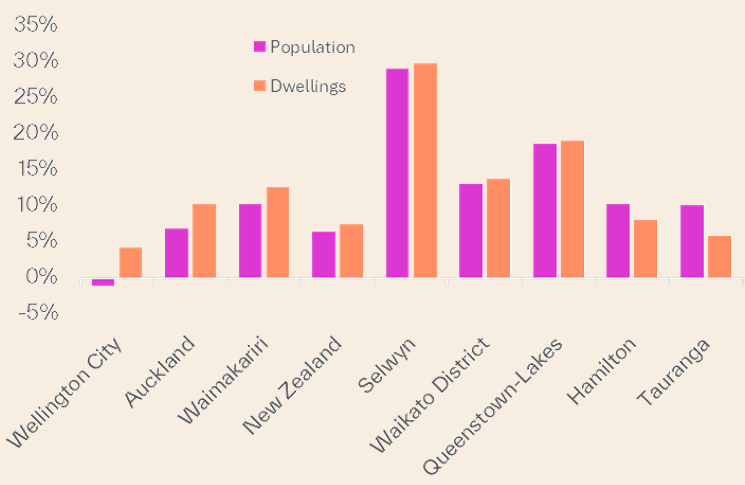A significant shift in the balance of supply and demand for residential properties across most of the country has contributed to the recent easing in house prices, according to property data company Cotality.
In Cotality's latest NZ Property Pulse report, the company's Chief Property Economist Kelvin Davidson said Auckland and Wellington were the main areas where property supply had outpaced population growth between 2019 and 2024.
"In Wellington, the population actually saw a small decline of 1.0% in the five years to 2024, while the dwelling stock increased by 4.3% - this caused the occupancy rate to drop from 2.97 [residents per dwelling] to 2.82," the report said.
While the recent property value downturn is partly an unwinding of previous affordability stress, this loosening of the supply and demand balance also played a role," it said.
A similar situation existed in Auckland.
"Auckland's population grew by a robust 7.0% over the same period, but this was exceeded by an even stronger 10.3% increase in dwelling stock - this eased Auckland's occupancy rate from 3.45 to 3.34, " the report said.
"This easing in the physical supply and demand balance aligns with the weakness in Auckland's property values, although it is also worth noting that the recent construction mix in Auckland has been dominated by townhouses, which are smaller and have a naturally lower occupancy rate," it said.
Other areas where the supply of housing outpaced population growth were Waimakariri and Selwyn in Canterbury and Queenstown-Lakes.
Going against the trend, population growth outstripped housing supply in Hamilton and Tauranga.
"Hamilton's population increased by 10.3%, while its dwellings grew by 8.1% and Tauranga saw population growth of 10.2% compared to a 5.9% rise in dwellings.
"Although these areas are not experiencing a property value boom, their markets have been more resilient than those in Auckland and Wellington, with less improvement in housing affordability," the report said.
The comment stream on this article is now closed.
Percentage Change in Population and Dwellings in Key Urban Areas 2019-2014

24 Comments
Can people please stop building houses in Auckland?
Not as fast as Aucklanders leave for Aussie apparently.
Because the new houses are often expensive shit boxes, this bodes very very badly for construction and manufacturing as we saw Q2 GDP
It doesn't make sense when there are close to 6,000 rentals advertised, few buyers and minimal immigration into NZ.
I think for some, development is seen as the best way out of an over priced land purchase
I’ve seen many youtube channels by foreigners living in Auckland and explaining why it isn’t a great place to live if coming to NZ. Perhaps the word is spreading after years of recession that there isn’t as mich hope of a better life here in NZ than in other countries.
That seems very self serving Zach. Lets remember this is a massive part of the economy and employs a lot of people, supply chain and tradies. They also pay a lot of tax.
Should we sacrifice all of that for the tax avoiding profit of the Lords of Leverage?
Building a lot more here could leverage the oversupply, and smash prices down.....
What? This is unheard of. We're not running out of houses any more?
Seriously though, there will always be the group that, by their own choosing, awaken to find themselves in unknown territory.
Houses are for living in!
Indeed. If this trend continues then the unoccupied and leveraged will be having uncomfortable banking conversations.
Popcorn
Yeah, don't you hate it when the free market brings down the cost of living? Let's get back to a time of scarcity.
The sometimes illiquid nature of housing can start when the foundations go in. Expect more mortgagee sales of land quoting amazing construction opportunities.
So amazing the bank is selling it up...
Went onto the Fletcher Living website a week or so ago. Doesn't seem any pressure there to drop prices. Would only be interested in a shitbox at $750 to 850k if they dropped another $100k. For those advertised at just above $1mill would need to drop $150k to $200k.
So Cotatilty say “ Auckland has been dominated by townhouses, which are smaller and have a naturally lower occupancy rate” - really? So how does that explain the s…t boxes with 3-5 bedrooms, no or a single car park and not enough outdoor space to swing a Guinea pig?
Lower occupancy rate as the developers only sell a couple at a time to try not to flood the market and lower the offers coming in. Therefore we have a glut of townhouses as people haven’t been buying fir a while and dev’s wont list say the whole 10 in the block or buyers will lowball offers harder than they already are, if at all.
I despise the zoning rules that allow no carparks far from main public transport hubs/routes. 8 families where there used to be 1. 8-16 cars on the street. Slums of the future. Everything built today more than 750m from a bus stop or a train station should have to have at least one car park per dwelling by law, or there should be a shared carparking facility set up for all of the developments in the vicinity.
Agreed.
I don't mind no car parks as long as the surrounding streets have no on-street parking. Lots of side streets in Auckland are now effectively one way and it's a pain in the rear for everyone.
Those kind of rules are what made houses expensive in the first place.
Public transport availability does not equate to it being used. Those living close still want and have a car and usually multiple cars. Streets are becoming congested with parked cars.
Where's that picture of the development from?
My guess is AI.
Good, now the developers will need to compete by offering quality products to win the buyers
Can’t. Cost to build is still way too high.
But I saw on the news last night that a building recovery is underway. 🤔


We welcome your comments below. If you are not already registered, please register to comment.
Remember we welcome robust, respectful and insightful debate. We don't welcome abusive or defamatory comments and will de-register those repeatedly making such comments. Our current comment policy is here.